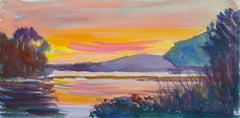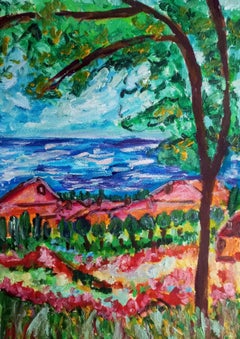Nelson White Landscape Drawings and Watercolors
American, b. 1932
Nelson H. White was born in New London, Connecticut in 1932. White has been surrounded by art and artists from the time he was born. He received his earliest art instruction from his grandfather, Henry Cooke White (1861-1952) and his father Nelson Cooke White (1900-1989), both important American artists. The family lived in Waterford, Connecticut and the elder White had been an early member of the art colony in Old Lyme, Connecticut. Known for his paintings of the Connecticut landscape and shoreline, Henry Cooke White became a teacher to his son, Nelson Cooke White. Living with his parents at the Florence Griswold house in Old Lyme, he met some of the most important and influential artists of the day, Childe Hassam, Will Howe Foote and Harry Hoffman.
Later, Nelson White's father began to take his family to summer on Shelter Island and became friendly with many of the artists of the Peconic colony such as Irving Wiles, an important American impressionist. After graduating from the Tabor Academy in Marion, Massachusetts in 1951, Nelson H. White began to study at Mitchell College in Connecticut but left to pursue studies in the violin, musical theory and composition. At this time, he began to spend more time studying art with his father and grandfather. By 1955, Nelson H. White had decided to devote himself to a career as a painter and traveled to Florence, Italy to become an apprentice to Pietro Annigoni, the world-renowned Florentine master. Within two years, the young White had won two awards for his work. While in Florence he also studied with the great Italian teacher, Nerina Simi. Today, White divides his time between the United States and Florence. White is still actively involved with studies at The Florence Academy of Art in Florence, Italy.
Although he has received instruction from some very important artists, White's work is highly individual. He paints with great spirit. Upon seeing his work one quickly senses White’s great love for nature and the outdoors. Through his eyes we are able to view and interpret nature in an intimate manner. Whether Nelson H. White is painting the Connecticut shore, a beach in Italy, a pond on Shelter Island or the hills of Vermont, he allows the observer to view a soft, yet dramatic side of nature. His ability to use color, coupled with rich brush work and a graduation of light, air and atmosphere allows one to enjoy a certain mood which is clearly conveyed in White's paintings. It is a mood that leaves us with a lasting impression.
White has shown his work in numerous galleries across the globe since the 1950s, from the United States all the way to Italy and Russia. White's first museum restrospective was in the New Britain Museum of American Art in July 2012. His work can be found in many private and public collections, as well as several museums.to
1
Overall Width
to
Overall Height
to
1
1
1
1
1
78
143
123
66
60
1
1
Artist: Nelson White
"Sunset (Shelter Island) 06.06.2021" watercolor of colorful seascape and sky
By Nelson White
Located in Sag Harbor, NY
Painted en plein air.
Frame Dimensions: 9 x 15in
Artist Bio:
Nelson H. White was born in New London, Connecticut in 1932. White has been surrounded by art and artists from the time he was born. He received his earliest art instruction from his grandfather, Henry Cooke White (1861-1952) and his father Nelson Cooke White (1900-1989), both important American artists. The family lived in Waterford, Connecticut and the elder White had been an early member of the art colony in Old Lyme, Connecticut. Known for his paintings of the Connecticut landscape and shoreline, Henry Cooke White became a teacher to his son, Nelson Cooke White. Living with his parents at the Florence Griswold house in Old Lyme, he met some of the most important and influential artists of the day, Childe Hassam, Will Howe Foote and Harry Hoffman.
Later, Nelson White's father began to take his family to summer on Shelter Island and became friendly with many of the artists of the Peconic colony such as Irving Wiles, an important American impressionist. After graduating from the Tabor Academy in Marion, Massachusetts in 1951, Nelson H. White began to study at Mitchell College in Connecticut but left to pursue studies in the violin, musical theory and composition. At this time, he began to spend more time studying art with his father and grandfather. By 1955, Nelson H. White had decided to devote himself to a career as a painter and traveled to Florence, Italy to become an apprentice to Pietro Annigoni, the world-renowned Florentine master. Within two years, the young White had won two awards for his work. While in Florence he also studied with the great Italian teacher, Nerina Simi. Today, White divides his time between the United States and Florence. White is still actively involved with studies at The Florence Academy of Art in Florence, Italy.
Although he has received instruction from some very important artists, White's work is highly individual. He paints with great spirit...
Category
21st Century and Contemporary Impressionist Nelson White Landscape Drawings and Watercolors
Materials
Watercolor
Related Items
19th C. American Impressionist Gouache of Colorado Mountains in Spring
By Charles Partridge Adams
Located in Denver, CO
This original circa 1910s plein air field study by renowned Colorado landscape artist Charles Partridge Adams captures the serene beauty of the Rocky Mountains in a masterful display...
Category
1910s American Impressionist Nelson White Landscape Drawings and Watercolors
Materials
Gouache
$1,880
H 13.75 in W 17.75 in D 0.75 in
Contemporary impressionist seascape nature acrylic painting on paper
Located in VÉNISSIEUX, FR
This vibrant and evocative artwork "My sweet summer Provence " presents a picturesque seaside landscape, painted with bold strokes and a vivid color palette that instantly captivate...
Category
2010s Impressionist Nelson White Landscape Drawings and Watercolors
Materials
Paper, Acrylic, Watercolor
$471 Sale Price
30% Off
H 16.54 in W 11.62 in D 0.04 in
California Vineyard, Large-Scale Farmhouse Landscape Watercolor
By Carolyn Hofstetter
Located in Soquel, CA
Vibrant large-scale landscape watercolor of a California vineyard by S.W.A. artist Carolyn Hofstetter (American, b.1927). This beautiful scene of ...
Category
Late 20th Century American Impressionist Nelson White Landscape Drawings and Watercolors
Materials
Paper, Watercolor
$1,080 Sale Price
20% Off
H 28.25 in W 34.25 in D 0.75 in
Contemporary impressionist landscape nature watercolor painting on paper
Located in VÉNISSIEUX, FR
This artwork "Magic place from my childhood" is a compelling landscape painting that captures the dynamic essence of nature through vigorous brushstrokes and a vivid color palette.
...
Category
2010s Impressionist Nelson White Landscape Drawings and Watercolors
Materials
Paper, Acrylic, Watercolor
$471 Sale Price
30% Off
H 11.62 in W 16.54 in D 0.04 in
Pt. Pinos California, Coastal Figural Landscape Watercolor
By Donald J. Phillips
Located in Soquel, CA
Pt. Pinos California, Coastal Figural Landscape Watercolor
Striking depiction of a lighthouse by Donald J. Phillips (American, 20th Century). Signed and dated "DONALD J. PHILLIPS WW/7-89" in the lower right corner. Tag on verso with artist and exhibition information. Presented in a double mat of white and cream, in a green metal frame with glass. Image size: 21"H x 15"W
Donald J. Phillips (American, 20th Century) is an artist from San Leandro, CA. He attended California College of Arts and Crafts in Oakland, where he met his wife. Phillips served in Marine Corps Reserve and was called to duty from 1950-1951 during the Korean War.
Exhibitions and Memberships:
21st Annual Santa Cruz Art Exhibit, 1950
New England Watercolor...
Category
1980s American Impressionist Nelson White Landscape Drawings and Watercolors
Materials
Paper, Watercolor
$487 Sale Price
35% Off
H 28 in W 21 in D 1 in
Pair of Impressionist Mediterranean Garden Views. Gouache & Watercolor on Paper
Located in Cotignac, FR
Pair of early 20th Century French watercolours of a Mediterranean garden. The paintings are signed bottom right, Songa, and are presented under a hand coloured custom mount in a plain wood frame under glass.
A pair of charming representations of a garden in spring and early summer.
The first shows a line of majestic Cyprus trees...
Category
Early 20th Century Impressionist Nelson White Landscape Drawings and Watercolors
Materials
Watercolor, Gouache, Paper
$1,148 Sale Price
20% Off
H 26.78 in W 32.09 in D 0.4 in
Jurassic Cliffs Dorset Coast 1970s British Watercolour Landscape Painting
Located in Cirencester, Gloucestershire
Title: Jurassic Cliffs Dorset Coast 1970s British Watercolour Landscape Painting
by John Steane (b.1931)
Size: 15.5 inches (height) x 23 inches (width)
watercolor painting on paper, ...
Category
Late 20th Century Impressionist Nelson White Landscape Drawings and Watercolors
Materials
Watercolor
Island in the San Francisco Bay, Mid Century Landscape by Alexander Nepote
By Alexander Nepote
Located in Soquel, CA
Mid Century Island in the San Francisco Bay Landscape by Alexander Nepote
Lovely late 1930's Impressionist watercolor of a Bay Area island by listed California artist Alexander Nepo...
Category
1930s American Impressionist Nelson White Landscape Drawings and Watercolors
Materials
Paper, Watercolor
$1,397 Sale Price
35% Off
H 24 in W 30 in D 0.25 in
Victorian vintage art by Dibdin, watercolor tempera - 1863
Located in PARIS, FR
Excellent condition. Mint.
Free US CONTINENTAL shipping, incl Europe and Asia.
Thomas Colman Dibdin was an illustrator and painter. Born at Bletchworth, Surrey, on 22 October 1810,...
Category
Late 19th Century Impressionist Nelson White Landscape Drawings and Watercolors
Materials
Watercolor, Gouache, Carbon Pencil
$2,654
H 20.86 in W 29.13 in
Jake Lee "Tractor in the Barn" Original Watercolor Painting c.1990
By Jake Lee
Located in San Francisco, CA
Fine watercolor painting by noted American artist Jake Lee
Though untitled, we are calling this "Tractor in the Barn".
A nice farm scene with chickens outside a barn.
Dimensions 1...
Category
Late 20th Century Impressionist Nelson White Landscape Drawings and Watercolors
Materials
Watercolor, Archival Paper
$575
H 17 in W 21 in D 2 in
An Impressionist Mediterranean Garden in Spring. Watercolor & Gouache on Paper.
Located in Cotignac, FR
Early 20th Century French watercolour of a Mediterranean garden. The painting is signed bottom right and mid right, Songa, and is presented under a hand coloured custom mount in a pl...
Category
Early 20th Century Impressionist Nelson White Landscape Drawings and Watercolors
Materials
Paper, Watercolor, Gouache
$717
H 26.78 in W 32.09 in D 0.4 in
Carl Martin Western Mountain Landscape Watercolor Painting c.1970
Located in San Francisco, CA
Carl Martin Western Mountain Landscape Watercolor Painting c.1970
Outstanding watercolor signed Carl Martin
Original watercolor on paper
...
Category
Mid-19th Century Impressionist Nelson White Landscape Drawings and Watercolors
Materials
Watercolor
$550
H 37 in W 47 in D 2 in
Nelson White landscape drawings and watercolors for sale on 1stDibs.
Find a wide variety of authentic Nelson White landscape drawings and watercolors available for sale on 1stDibs. You can also browse by medium to find art by Nelson White in paint, watercolor and more. Much of the original work by this artist or collective was created during the 21st century and contemporary and is mostly associated with the Impressionist style. Not every interior allows for large Nelson White landscape drawings and watercolors, so small editions measuring 12 inches across are available. Customers who are interested in this artist might also find the work of Charles Partridge Adams, Carl Oscar Borg, and Natasha Isenhour. Nelson White landscape drawings and watercolors prices can differ depending upon medium, time period and other attributes. On 1stDibs, the price for these items starts at $2,400 and tops out at $2,400, while the average work can sell for $2,400.


